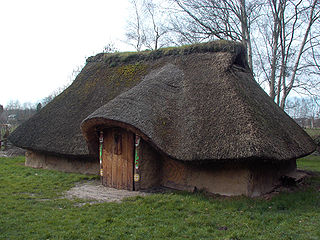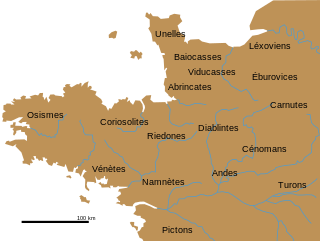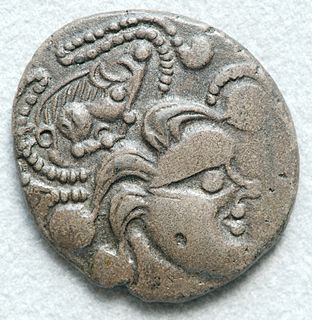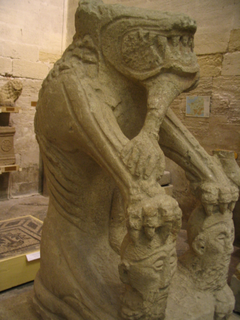Related Research Articles

The Menapii were a Belgic tribe of northern Gaul in pre-Roman and Roman times. According to descriptions in such authors as Strabo, Caesar, Pliny the Elder and Ptolemy their territory had stretched northwards to the mouth of the Rhine in the north, but more lastingly it stretched along the west of the Scheldt river. In later geographical terms this territory corresponds roughly to the modern Belgian coast, the Belgian provinces of East and West Flanders. It also extended into neighbouring France and the river deltas of the Southern Netherlands.

The Viducasses were a Gallic tribe of Gallia Lugdunensis.

The Senones or Senonii were an ancient Gallic tribe that dwelled in the Seine basin, around present-day Sens, in Caesar's time.
The Morini were a Belgic coastal tribe, dwelling in the modern Pas de Calais region, around present-day Boulogne-sur-Mer.

The Petrocorii were a Gaulish tribe located in the present-day Dordogne region of France, between the Dordogne and Isle rivers. Their capital was Vesunna, which is today the town of Périgueux. Périgueux as well as the ancient province of Périgord take their names from this tribe.

The Bodiocasses were an ancient Gallic tribe of the Roman period. They were a tribal division of the civitas of the Lexovii, in the Roman province of Gallia Lugdunensis.

The Cavares were a confederation of Gallic tribes located in the lower Rhone valley during the Roman period. Their strongholds were Avignon (Avennio), Orange (Arausio) and Cavaillon (Cabellio).

The Parisii were a Gallic tribe dwelling on the banks of the river Seine, on lands now occupied by the modern city of Paris, during the Iron Age and the Roman era.
The Caletes or Caleti were a Belgic or Gallic tribe dwelling in Pays de Caux, in present-day Normandy, during the Iron Age and the Roman period.
The Lemovices or Lemovici were a Gallic tribe, dwelling in the modern Limousin region.

The Eburovices, AulerciEburovices or Eburovici were a Gallic tribe, a branch of the Aulerci. They are mentioned by Julius Caesar with the Lexovii. Pliny speaks of the Aulerci, qui cognominantur Eburovices, et qui Cenomani. Ptolemy makes the Αὐλέρκοι Ἐβουραϊκοί extend from the Ligeris to the Sequana, which is not true. Their chief place was Mediolanum Aulercorum. Their limits correspond to those of the later diocese of Évreux, and they are north of the Carnutes.

The Diablintes or Diablintres or Diablindi or Aulerci Diaulitae were an ancient people of Gaul, a division of the Aulerci. Julius Caesar mentions the Diablintes among the allies of the Veneti and other Armoric states whom Caesar attacked. The Diablintes are mentioned between the Morini and Menapii. The territory of the Diablintes seems to have been small, and it may have been included in that of the Cenomanni, or the former diocese of Mans.

The Riedones were a Gallic tribe, dwelling around their capital Condate. Caesar mentions the Redones among the civitates maritimae or Aremoricae.
The Tricasses were a Gallic tribe dwelling on the upper Seine and the Aube rivers during the Roman period. Until the first century AD, they were probably reckoned among the Senones.

The Andecavi were a Gallic tribe of ancient and early medieval Aremorica.

The Segusiavi were a Gallic tribe dwelling around the modern city of Feurs, in the modern Auvergne-Rhône-Alpes region in central France.
The Veliocasses were a Belgic or Gallic tribe of the La Tène and Roman periods, dwelling in the south of modern Seine-Maritime and in the north of Eure.
The Caeroesi and the Caeracates were small Belgic-Germanic tribes dwelling in Gallia Belgica during the Iron Age and the Roman period. Their ethnic identity remains uncertain. Caesar described them as part of the Germani Cisrhenani, but their tribal names are probably of Celtic origin. Like other Germani Cisrhenani tribes, it is possible that their old Germanic endonym came to be abandoned after a tribal reorganization, that they received their names from their Celtic neighbours, or else that they were fully or partially assimilated to Celtic culture at the time of the Roman invasion of the region in 57 BC.
The Cadurci were a Gallic tribe living in the region of Quercy.
The Silvanectes were a small Belgic tribe dwelling around present-day Senlis, Oise.
References
- 1 2 3 Foster 2000, p. 4.
- 1 2 3 Sims-Williams 2007, pp. 329–330.
- 1 2 Falileyev 2010, s.v. Menapii.
- ↑ Isaac, Graham, "Place-Names in Ptolemy's Geography : An Electronic Data Base with Etymological Analysis of Celtic Name Elements". CD-ROM. 2004, CMCS Publications, Aberystwyth.
Bibliography
- Falileyev, Alexander (2010). Dictionary of Continental Celtic Place-names: A Celtic Companion to the Barrington Atlas of the Greek and Roman World. CMCS. ISBN 978-0955718236.
- Foster, R. F. (2000). The Oxford Illustrated History of Ireland. Oxford University Press. ISBN 978-0-19-289323-9.
- Sims-Williams, Patrick (2007). "Common Celtic, Gallo-Brittonic and Insular Celtic". In Lambert, Pierre-Yves; Pinault, Georges-Jean (eds.). Gaulois et Celtique Continental. Librairie Droz. ISBN 978-2600013376.
| This Irish history article is a stub. You can help Wikipedia by expanding it. |